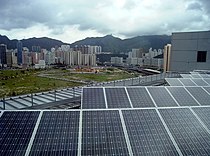A zero-carbon city is a goal of city planners[1] that can be variously defined. In a narrower sense of energy production and use, a zero-carbon city is one that generates as much or more carbon-free sustainable energy as it uses.[2][3] In a broader sense of managing greenhouse gas emissions, a zero-carbon city is one that reduces its carbon footprint to a minimum (ideally 0 or negative) by using renewable energy sources; reducing all types of carbon emissions through efficient urban design, technology use and lifestyle changes; and balancing any remaining emissions through carbon sequestration.[4][5][6] Since the supply chains of a city stretch far beyond its borders, Princeton University's High Meadows Environmental Institute suggests using a transboundary definition of a net-zero carbon city as "one that has net-zero carbon infrastructure and food provisioning systems".[7]
Most cities throughout the world burn coal, oil or gas as a source of energy, resulting in the release of carbon dioxide into the atmosphere, a key greenhouse gas. The development of cities is therefore intimately linked to the causes and impacts of climate change.[4][8] As of 2019[update], cities accounted for two thirds of all energy consumption and generated 70% of energy-related greenhouse gas emissions.[9][10][11] Over 50% of the people in the world currently live in cities, a proportion that is projected to rise to 70% by 2050, and almost 80% by 2080.[5]

Urban development focused on lowering carbon is seen as an inevitable trend for sustainability in urban spaces.[8][12][13] Underlying goals include avoiding harm to the planet and countering the impacts of climate change.[5] As of 2022[update], over 1000 cities worldwide have undertaken steps to transition in response to climate change as part of the Cities Race to Zero campaign,[14] one part of a larger United Nations Race to Zero campaign.[15] Among them are cities including Rio de Janeiro, New York, Paris, Oslo, Mexico City, Melbourne, London, Milan, Cape Town, Buenos Aires, Caracas, Copenhagen, Vancouver[16] and Hong Kong.[17] In the United States, more than 100 cities have pledged to become carbon neutral.[18]
An established modern city attempting to achieve net-zero status needs to assess seven key provisioning systems, for energy, transportation-communications, food, construction materials, water, green infrastructure, and waste-management.[7][19][1] Strategies for reaching net zero include developing renewable energy supplies, reducing energy and resource use through better urban design and lifestyle changes, reducing waste, and creating green spaces and carbon sinks to remove carbon from the atmosphere.[4][8] Approaches to sustainable urban planning of zero carbon cities increasingly emphasize the use of locally sourced food, energy, and renewable resources.[20]
Some city planners have designed zero-carbon cities from scratch, instead of using and adapting established cities. This gives city planners greater control over all aspects of city design and how each city can contribute to being without carbon emissions. Such design enables the city to benefit from economies of scale and from construction options that might not be feasible in a city with existing structures. Such zero-carbon cities maintain optimal living conditions and economic development while eliminating environmental impact.[12]
- ^ a b Fuller-Wright, Liz (March 30, 2022). "What climate choices should cities make? A Princeton data tool helps planners set priorities". Princeton University. Retrieved 31 August 2022.
- ^ "Net Zero City Definition". Law Insider. Retrieved 27 September 2022.
Net Zero City means a city that produces sustainable, carbon free energy in amounts equal to, or exceeding, the amounts which it consumes...
- ^ "DOCSOC/1508196v1/022283-0050 Memorandum of Understanding". City of Lancaster. 2011. Retrieved 27 September 2022.
- ^ a b c Padmanaban, Deepa (9 June 2022). "How cities can fight climate change". Knowable Magazine. doi:10.1146/knowable-060922-1. Retrieved 31 August 2022.
- ^ a b c Towards the Zero-Carbon City (PDF). HSBC Centre of Sustainable Finance. July 2019.
- ^ Allen, Myles R.; Friedlingstein, Pierre; Girardin, Cécile A.J.; Jenkins, Stuart; Malhi, Yadvinder; Mitchell-Larson, Eli; Peters, Glen P.; Rajamani, Lavanya (17 October 2022). "Net Zero: Science, Origins, and Implications". Annual Review of Environment and Resources. 47 (1): annurev–environ–112320-105050. doi:10.1146/annurev-environ-112320-105050. hdl:11250/3118584. ISSN 1543-5938. S2CID 251891777.
- ^ a b Kelly, Morgan (May 13, 2021). "What is a net-zero city? Depends on how you count urban carbon emissions". High Meadows Environmental Institute. Princeton University. Retrieved 31 August 2022.
- ^ a b c Seto, Karen C.; Churkina, Galina; Hsu, Angel; Keller, Meredith; Newman, Peter W.G.; Qin, Bo; Ramaswami, Anu (18 October 2021). "From Low- to Net-Zero Carbon Cities: The Next Global Agenda". Annual Review of Environment and Resources. 46 (1): 377–415. doi:10.1146/annurev-environ-050120-113117. ISSN 1543-5938. S2CID 238677484.
- ^ Owen-Burge, Charlotte (6 May 2021). "Carbon neutral cities: Can we fight climate change without them?". Climate Champions. Retrieved 31 August 2022.
- ^ "Cities: a "cause of and solution to" climate change". UN News. 18 September 2019. Retrieved 31 August 2022.
- ^ Cite error: The named reference
IEA2021was invoked but never defined (see the help page). - ^ a b Peng, Yuan; Bai, Xuemei (2018-02-10). "Experimenting towards a low-carbon city: Policy evolution and nested structure of innovation". Journal of Cleaner Production. 174: 201–212. Bibcode:2018JCPro.174..201P. doi:10.1016/j.jclepro.2017.10.116. hdl:1885/139438. ISSN 0959-6526. S2CID 158957107.
- ^ Morris, Langdon; Naz, Farah (2021). Net zero city : the ten-year transformation plan : how to overcome the climate crisis by 2032. Langdon Morris. ISBN 979-8465361156.
- ^ Cite error: The named reference
Wraywas invoked but never defined (see the help page). - ^ Cite error: The named reference
Bindmanwas invoked but never defined (see the help page). - ^ Cite error: The named reference
Brownwas invoked but never defined (see the help page). - ^ "Who's in Race to Zero?". United Nations Climate Change. Retrieved 20 September 2022.
- ^ Cite error: The named reference
C40-USAwas invoked but never defined (see the help page). - ^ Cite error: The named reference
Ramaswamiwas invoked but never defined (see the help page). - ^ Cite error: The named reference
Dabaiehwas invoked but never defined (see the help page).